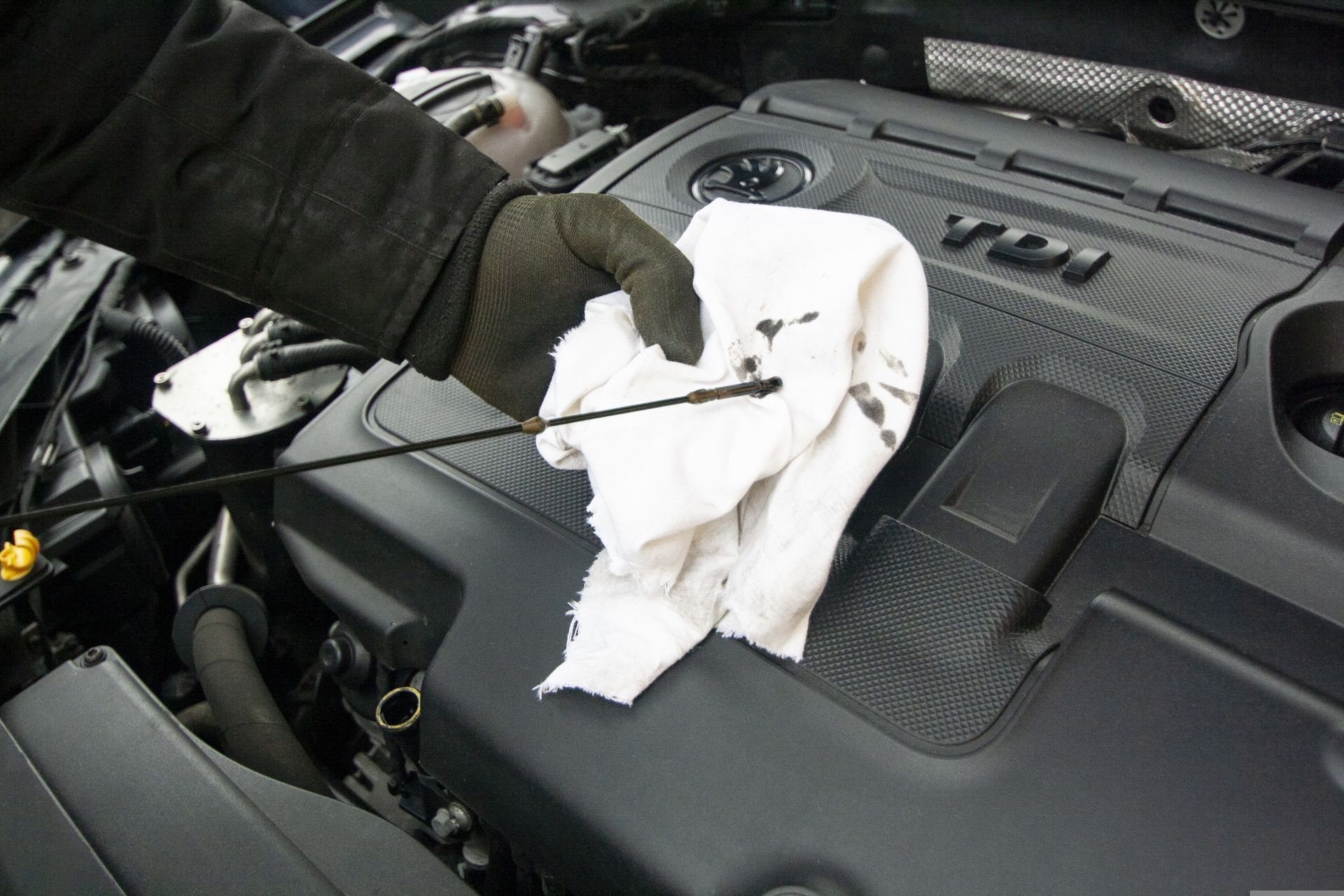How Does the Oil Change Sensor Work?
At Auto Centric, we often get questions from Grand Rapids drivers about when to change their oil. Many modern vehicles now come equipped with an oil change sensor that takes the guesswork out of maintenance timing.
The oil change sensor works by monitoring various conditions like engine revolutions, operating temperatures, driving time, and oil quality to determine when you need an oil change. Unlike older vehicles that relied on simple mileage counts, these advanced systems analyze real-world conditions to give you a more accurate recommendation.
Michigan's weather extremes can impact oil life, especially during harsh Grand Rapids winters. The sensor accounts for these factors, helping you maintain your vehicle properly without unnecessary service visits. When the sensor determines your oil needs changing, it will trigger a dashboard notification to let you know it's time to visit us.
The Oil Change Sensor
Oil change sensors help vehicle owners know when it's time to replace their engine oil without guessing. These intelligent systems monitor various conditions to determine the optimal time for maintenance.
Types of Oil Change Sensors
Most modern vehicles use one of two main oil monitoring systems. Algorithm-based systems track engine revolutions, operating temperatures, and driving time to calculate oil life. These don't actually measure the oil's condition but estimate wear based on usage patterns.
Direct measurement systems are more sophisticated. They use physical sensors that measure the oil's electrical conductivity, viscosity, or contamination levels. These provide more accurate readings of the actual oil condition.
We see both types in vehicles with newer models typically featuring more advanced sensors. Many luxury and high-performance vehicles now include sensors that can detect moisture content and acidity levels in the oil.
Role of the Oil Change Sensor in Engine Maintenance
The oil change sensor serves as your engine's guardian. It helps prevent premature engine wear by ensuring oil changes happen at the optimal time rather than arbitrary mileage intervals.
When working properly, these sensors extend engine life by:
- Preventing unnecessary early oil changes
- Warning when oil has degraded, even before mileage guidelines
- Adjusting recommendations based on driving conditions
We've noticed that Grand Rapids drivers who follow their oil life monitor recommendations typically experience fewer engine problems. The sensor accounts for our local driving conditions, including cold Michigan winters that can be tough on engine oil.
The system also creates maintenance records in your vehicle's computer, which helps with tracking service history and maintaining warranty coverage.
Oil Change Sensor Technologies
Modern vehicles use sophisticated sensors to monitor the condition of your oil and tell you when it's time for a change. Different manufacturers have developed their own technologies to track oil life based on various driving factors.
GM's Oil Life System
GM's Oil Life System uses an algorithm that tracks engine revolutions, temperature, and driving conditions to calculate oil life percentage. This system doesn't actually sense the oil condition but predicts when oil will degrade based on your driving habits.
When you drive in harsh conditions like stop-and-go traffic or in cold Grand Rapids winters, the system recognizes this stress on the engine oil. The onboard computer adjusts the oil life percentage accordingly.
We've found that GM's system can extend oil change intervals to 7,500-10,000 miles for many drivers with normal driving habits. The dashboard display shows the remaining oil life as a percentage, making it easy to plan maintenance visits to our Auto Centric shop.
BMW's Oil Condition Sensor
BMW takes a different approach with actual physical sensors that measure oil quality. Their system uses conductivity sensors that sit in the oil pan to detect changes in the oil's electrical properties.
As oil degrades, its dielectric constant changes. The BMW sensor measures these changes to determine when oil no longer provides adequate protection for your engine.
The system also factors in driving style, temperature, and mileage. In our Grand Rapids service center, we often see BMWs coming in with different maintenance intervals based on how they're driven.
BMW's technology is more precise than predictive algorithms because it directly measures the oil's condition. This helps prevent premature oil changes while ensuring your engine stays protected.
Ford's Intelligent Oil-Life Monitor
Ford's system calculates oil life using an algorithm that tracks engine load, temperature, and driving patterns. It considers cold starts (common in Grand Rapids winters) and short trips as factors that accelerate oil degradation.
We've noticed Ford's system typically recommends changes between 5,000-10,000 miles depending on driving conditions. Some of our customers who drive primarily on highways can go longer between services.
Ford's technology helps reduce unnecessary maintenance while ensuring your engine receives fresh oil when it truly needs it. At Auto Centric, we always reset the monitor after every oil change to ensure accurate tracking of your next service interval.
How the Oil Change Sensor Works
Modern vehicles use sophisticated oil change sensors to monitor oil condition and tell you when it's time for service. These systems help many of our Grand Rapids customers save money by avoiding unnecessary oil changes while ensuring their engines stay properly protected.
Oil Quality Sensing
The oil change sensor monitors your engine oil's condition through several methods. Most systems use electrical conductivity measurements to detect changes in the oil's properties. As oil ages, its electrical properties change due to oxidation and contamination.
Some advanced sensors include microprocessors that continuously analyze oil data while your vehicle runs. These systems can detect minute changes that occur over time as your oil breaks down.
At Auto Centric, we see many Grand Rapids drivers who are surprised to learn their vehicles don't simply track mileage. Instead, these sensors actively measure real-time oil condition to determine when service is needed.
The sensors are typically mounted in the oil pan or integrated into the oil filter housing where they have direct contact with the oil.
Measuring Oil Viscosity and Contaminants
Oil sensors measure viscosity—how thick or thin your oil is—which changes as oil ages. When oil breaks down, it becomes less effective at lubricating engine components.
The sensors detect contaminants like dirt, metal particles, and combustion byproducts that accumulate in oil over time. These particles increase friction and can damage engine parts if not addressed.
Some high-tech sensors use infrared technology to identify specific contaminants in the oil. This helps create a more accurate picture of oil health.
Temperature monitoring is also crucial since heat accelerates oil degradation. Sensors track how often your engine reaches high temperatures, which is common in Michigan's summer traffic.
We often explain to our Grand Rapids customers that their driving habits directly affect how quickly contaminants build up in their oil.
Factors Influencing Oil Change Sensors
Oil change sensors don't operate on a simple timer. They analyze several key factors to determine when your vehicle truly needs an oil change, helping you maintain your engine properly without unnecessary service.
Impact of Driving Habits
Driving habits significantly affect how quickly your oil degrades. Short trips around Grand Rapids don't allow your engine to reach optimal operating temperature, which means moisture and contaminants remain in the oil longer.
We see this frequently at Auto Centric with customers who primarily drive short distances. Their oil change sensors often trigger earlier than expected.
Highway driving typically extends oil life because the engine maintains consistent temperatures. This allows the oil to work efficiently and maintain its protective properties longer.
Frequent stop-and-go traffic in downtown Grand Rapids creates more stress on your engine, causing oil to break down faster than during steady highway commutes.
Engine Wear and Oil Service Needs
As engines age, they develop specific oil needs that sensors must account for. Older engines typically burn more oil and create more contaminants.
We've observed at our Grand Rapids shop that vehicles with over 100,000 miles often trigger their oil change sensors sooner than newer models.
Engine wear creates microscopic metal particles that mix with the oil. These particles accelerate oil breakdown and can damage engine components if not addressed.
Modern oil sensors measure these contaminants and adjust recommendations accordingly. They can detect when oil loses its lubricating properties due to age or contamination.
Some advanced sensors can even measure oil viscosity changes, which is crucial for maintaining proper engine protection.
Environment and Operating Conditions
Michigan's climate presents unique challenges for oil performance. During Grand Rapids winters, cold starts put extra stress on your oil.
When temperatures drop below freezing, oil thickens and circulates more slowly. This creates more friction until the engine warms up, which the sensors detect as increased oil stress.
We recommend winter-grade oils for our customers to combat these issues and help extend oil life during cold months.
Extreme heat in summer months can also accelerate oil degradation. Oil sensors account for these temperature extremes when calculating service intervals.
Dusty conditions and road salt during Michigan winters introduce more contaminants into your engine, affecting how quickly sensors recommend an oil change.
Interpreting Sensor Readings
Understanding your vehicle's oil change sensor readings helps you maintain your engine properly and avoid costly repairs. The system communicates important information about when service is needed.
The Oil Change Indicator Warning Light
When your oil change indicator light illuminates on your dashboard, it's telling you something important about your engine's condition. This warning light doesn't simply operate on mileage alone - it considers multiple factors including engine temperature, RPM ranges, and driving conditions specific to Grand Rapids' varied terrain.
Many of our customers in Grand Rapids are surprised to learn that stop-and-go traffic downtown affects oil life differently than highway driving to Holland or Kalamazoo.
The warning light typically appears yellow or amber rather than red, indicating maintenance is needed soon but not an emergency. We recommend scheduling service within 500 miles when this indicator appears.
Some newer models display a percentage of oil life remaining rather than a simple on/off light. This gives you better advance notice of upcoming maintenance needs.
Using Sensor Data for Better Maintenance
We can use sensor data to develop a more precise maintenance schedule for your specific driving patterns. This approach saves you money by avoiding unnecessary oil changes while ensuring your engine receives proper care.
At Auto Centric, we download this sensor data during your visit to better understand your vehicle's specific needs. This allows us to recommend the optimal oil type for your driving habits around Grand Rapids.
Visual inspection remains important even with advanced sensors. We check oil color and consistency alongside electronic readings to provide comprehensive service.
Many drivers reset their oil life monitors after changes. We can show you how to properly reset your specific model to maintain accurate readings.
When it’s time for an oil change, come by Auto Centric at 5355 Plainfield Avenue NE in Grand Rapids.











